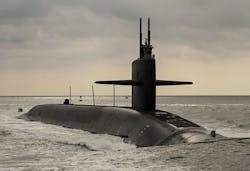Navy moves forward on common missile compartment for future U.S. and U.K. nuclear submarine
Officials of the Naval Sea Systems Command in Washington announced an $89.8 million contract modification last month to the General Dynamics Corp. Electric Boat segment in Groton, Conn., for missile tube long-lead time material for the common missile compartment program in support of the Ohio Class Replacement.
The Ohio replacement is being designed to replace the Navy's fleet of Ohio-class ballistic missile submarines -- each of which patrol the world's oceans carrying as many as 24 Trident II missiles as part of the U.S. nuclear deterrent triad that consists of ballistic missile submarines, nuclear bombers, and land-based intercontinental ballistic missiles.
The United Kingdom successor program, meanwhile, will replace the Royal Navy's fleet of Vanguard-class ballistic missile submarines. Long-lead items involve system components that require the longest time to build, which could delay overall system production if money isn't allocated for production early in the process.
Related: Lockheed Martin to manufacture new Trident II D5 submarine-launched nuclear missiles
The common missile compartment, being designed for the Ohio and Vanguard submarine replacement vessels, will house submarine-launched ballistic missiles in quad-packs aboard future U.S. and United Kingdom missile boats. The common missile compartment carry the UGM-133 Trident II nuclear missile, one of the most advanced submarine-launched atomic missiles in the world.
Officials of the Navy Strategic Systems Programs office in Washington are awarding a potential $99.2 million contract to Lockheed Martin Corp. to integrate the Trident II onto the next-generation ballistic submarine designs of the U.S. and United Kingdom.
Experts at the Lockheed Martin Space Systems segment in Sunnyvale, Calif., are integrating the Trident II missile and reentry strategic weapon system subsystems into the common missile compartment for the Ohio replacement and United Kingdom successor programs.
The U.S. Navy today operates 18 Ohio-class submarines -- 14 of which carry the Trident nuclear missile, and four of which have been modified to carry conventionally armed long-range cruise missiles. Lockheed Martin is prime contractor for the Trident II missile.
story continues below
Construction of the Ohio-class submarines began in 1976, and the submarines have been in commission at sea since 1981. Construction of Ohio-class submarines ceased in 1997 and submarines of the class are scheduled to be decommissioned and replaced starting in 2029.
The United Kingdom Vanguard-class ballistic missile submarine has been at sea since 1993. The Royal Navy operates four Vanguard-class subs.
Construction of the new Ohio replacement is scheduled to begin in 2021, and the first boat of the class should be commissioned and deployed at sea in 2031.
The Ohio replacement submarine, yet unnamed, will be 560 feet long -- the same length as the Ohio-class submarines -- and will have 16 missile tubes -- eight fewer tubes than the Ohio class. Plans now call for building 12 Ohio replacement submarines.
Each Ohio replacement boat will displace more than 20,000 tons, cost about $5 billion to build, and cost about $110 million each year to operate. Building the new submarines will be General Dynamics Electric Boat.
Related: Navy ship systems work moves forward in tough times
The Ohio replacement design effort will borrow from developments in the Virginia- and Seawolf-class attack submarines. Innovations planned for the Ohio replacement include an new electric propulsion system nuclear reactor to reduce maintenance time and costs.
This is a Joint U.S./United Kingdom contract that combines purchases for the U.S. Navy (34 percent) and the government of the United Kingdom (66 percent) under the Foreign Military Sales program.
On this contract modification General Dynamics Electric Boat will do th work in Quonset Point, R.I., and should be finished by December 2019. For more information contact General Dynamics Electric Boat online at www.gdeb.com, or Naval Sea Systems Command at www.navsea.navy.mil.
